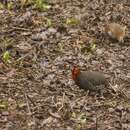Biology
provided by Arkive
The western tragopan lives in small family parties (7), and is believed to be primarily monogamous (6). Pairs start to form at the beginning of April, when males establish territorial calling perches, from which they call loudly throughout the day (6), and mating generally occurs between April and June (8). A rudimentary nest is established either on the ground or in trees, usually using the abandoned nest of another species (8). Clutches of two to six eggs (5) (8) are incubated solely by the female, although the male will help tend to the chicks once hatched (6). Family parties stay together for the autumn and winter (8), and like other tragopans, disperse again in spring, when males establish calling territories once more (6).
The diet primarily consists of leaves of trees and shrubs, but also includes roots, flowers, acorns, seeds, berries, grubs and insects (8). Tragopans are shy and wary birds; quick to hide amongst the dense vegetation they inhabit if disturbed (7).
Conservation
provided by Arkive
The western tragopan is legally protected in both India and Pakistan, and is found in several protected areas, including three national parks and ten wildlife sanctuaries (2) (5). The fairly recent discovery of a large population at Palas Valley, Pakistan, prompted a major conservation initiative in the region, the Himalayan Jungle Project, with this bird featuring as a flagship species (2) (5). The project, which was a cooperative initiative involving BirdLife International/WWF/WPA and the Government of Pakistan, promoted local participation in conservation by developing sustainable uses of the forest as alternatives to disruptive uses such as logging (5). This pheasant has also been the subject of several surveys since the early 1980s (5), and is currently the focus of a large conservation breeding programme in Himachal Pradesh, India (2). The Pakistan National Wildlife Council has also set up facilities for raising nestlings from eggs taken from the wild for later re-release (7).
Description
provided by Arkive
The darkest of all tragopans (5), males of this species are mostly greyish-black, ornately spotted with round, black-bordered white dots (6), and possess a conspicuous red collar, upper breast, and facial skin (2). Like other tragopans, males also boast a short crest along their crown, two brightly-coloured fleshy horns that become erect during courtship, and a brilliantly coloured bib-like lappet that hangs from the throat. The vivid blue lappet has purplish-blue markings down the centre, and pinkish-red patches at the margins, with pale blue indentations, and is expanded and exposed during courtship display. Females are more brownish grey, both above and below, and lack the colourful adornments of the male (6).
Habitat
provided by Arkive
Found during the breeding season (April to June) in little-disturbed temperate coniferous and deciduous forests, with heavy understorey, between 2,400 and 3,600 metres above sea level (2) (5). In winter, the western tragopan moves to grassy or shrubby gullies with less snow cover, between 1,750 and 2,500 metres above sea level (2).
Range
provided by Arkive
Endemic to the western Himalayas from the Kohistan district of north Pakistan, east through Kashmir into Himachal Pradesh and possibly Uttaranchal, north-west India (2).
Status
provided by Arkive
Classified as Vulnerable (VU) on the IUCN Red List 2007 (1) and listed on Appendix I of CITES (3).
Threats
provided by Arkive
The small remaining western tragopan population is declining and becoming increasingly fragmented in the face of deforestation throughout its restricted range and ongoing hunting pressure (2). Habitat loss and degradation pose the greatest threats to this bird, as a result of commercial timber extraction, tree-felling for conversion to agriculture, browsing of understorey shrubs by livestock, tree-lopping for animal fodder and fuel-wood collection (2) (5). Additionally, disturbance by farmers and their herds of goats, and by humans collecting edible fungi and medicinal plants, may seriously interfere with nesting of this shy species during the breeding season (2) (5). This stunning bird is also hunted for its meat and decorative plumage (2).

